Chişinău
| Chişinău | |||
 |
|||
|
|||
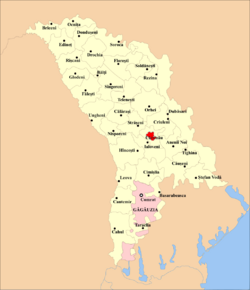 |
|||
| Coordinates: | |||
| Country | Moldova | ||
|---|---|---|---|
| Founded | 1436 | ||
| Government | |||
| - Mayor | Dorin Chirtoacă, since 2007 | ||
| Area | |||
| - City | 120 km² (46.3 sq mi) | ||
| - Urban | 635 km² (245.2 sq mi) | ||
| Elevation | 85 m (279 ft) | ||
| Population (2007) | |||
| - City | 592,900 | ||
| - Density | 4,938/km² (12,789.4/sq mi) | ||
| - Urban | 785,000 | ||
| - Metro | 911,400 | ||
| Time zone | EET (UTC+2) | ||
| - Summer (DST) | EEST (UTC+3) | ||
| Postal code | MD-20xx | ||
| Area code(s) | +373 22 | ||
| Website: www.chisinau.md | |||
Chişinău (IPA: [ki.ʃi.'nəw]) (also known as Kishinev, Russian: Кишинёв, Kishinyov), is the capital and largest city of Moldova. It is also its main industrial and commercial center and is located in the center of the country, on the river Bîc. Economically, the city is the most prosperous in Moldova and is one of the main transportation hubs of the region. As the most important city in Moldova, Chişinău has a broad range of educational facilities. The proportion of green spaces in the city is one of the highest among major European cities.
Contents |
Name
According to one version, the name comes from the archaic Romanian word chişla (meaning "spring", "source of water") and nouă ("new"), because it was built around a small spring. Nowadays, the spring is located at the corner of Pushkin and Albişoara streets.[1]
There is another city named Chişineu (alternative spelling: Chişinău) in Western Romania, near the border with Hungary, but its relation to Chişinău is disputed. Its Hungarian language name is Kisjenő (kis "small" + the eponym "Jenő", the equivalent of the English "Eugene," pronounced yenə), from which the Romanian name originates.
Chişinău is also known in Russian as Кишинёв (Kishinyov). It is written Kişinöv in the Latin Gagauz alphabet. It was also written as Кишинэу in the Moldovan Cyrillic alphabet in Soviet times. Historically, the English language name for the city, "Kishinev," was based on the modified Russian one because it entered the English language via Russian at the time Chişinău was part of the Russian Empire (e.g. Kishinev pogrom). Therefore, it remains a common English name in some historical contexts. Otherwise, however, the Romanian-based "Chişinău" has been steadily gaining wider currency, especially in the written language.
The municipality
Moldova is administratively subdivided into 32 districts, 2 autonomous units, and 3 municipalities. Chişinău is one of the municipalities.[2]
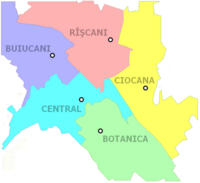
Besides the city itself, the municipality comprises 34 other suburban localities, and is subdivided into sectors, each comprising a part of the city itself and several suburbs.[3] The municipality in its totality elects a mayor and a local council, which then name 5 pretors, one for each sector. The five sectors of Chişinău are:
- Botanica
- Buiucani
- Centru
- Ciocana
- Râşcani
Geography and climate
Geography
Chişinău is located on the river Bîc, a tributary of the Dniester, at , with an area of 120 km². The whole municipality claims 635 km².
The city lies in the middle of the central area of Moldova.
Geographically convenient in the largely flat Eastern European country, the city is surrounded by a relatively level landscape with very fertile ground, offering the basis for the cultivation of grapevine and fruit since medieval times.
Climate
Chişinău has a continental climate, characterized by hot dry summers and cold windy winters. Winter temperatures are often below 0°C, although they rarely drop below -10°C. In summer, the average temperature is approximately 25°C, however, temperatures sometimes reach 35-40°C in mid-summer in the city center. Although average precipitation and humidity during summer is low, there are infrequent yet heavy storms. Spring and autumn temperatures vary between 16-24°C, and precipitation during this time tends to be higher than in summer, with more frequent yet milder periods of rain.
History
Founded in 1436 as a monastery town, the city was part of the Moldavian Principality, which, starting with the 16th century fell under the suzerainty of the Ottoman Empire. At the beginning of the 19th century it was a small town of 7,000 inhabitants. In 1812 it was came under Russian imperial administration, which made it the capital of the newly annexed gubernia of Bessarabia. Its population had grown to 92,000 by 1862 and to 125,787 by 1900.
Industrial age

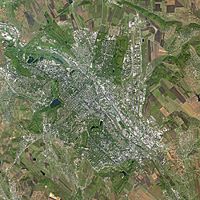
By 1834, an imperial townscape with broad and long roads had emerged as a result of a generous development plan, which divided the city roughly into two areas: The old part of the town - with its irregular building structures - and a newer City Center and station. Between 26 May 1830 and 13 October 1836 the architect Avraam Melnikov established the 'Catedrala Naşterea Domnului' (an Eastern Orthodox cathedral) with a magnificent bell tower. In 1840 the building of the Triumphal arch, planned by the architect, Luca Zaushkevich, was completed. Following this the construction of numerous further buildings and landmarks began. The town also played an important part in a war between Russia and Turkey (1877–78), as the main staging area of the Russian invasion.
Pogrom and Pre-Revolution
In the late 19th century, especially due to growing anti-semitic sentiment in the Russian Empire and better economic conditions, many Jews chose to settle in Chişinău. By the year 1900, 43% of the population of Chişinău was Jewish - one of the highest numbers in Europe.
However, during 6 - 7 April 1903 a large anti-Semitic riot took place in the town, which would later be known as the Kishinev pogrom. The events spanned three days of rioting, with 47-49 Jews killed, 92 severely wounded, and 500 suffering minor injuries. In addition, several hundred houses and many businesses were plundered and destroyed. The pogroms are largely believed to have been incited by anti-Jewish propaganda in the only official newspaper of the time, 'Bessarabetz' (Бессарабецъ). The reactions to this incident included a petition to Tsar Nicholas II of Russia on behalf of the American people by the US President Theodore Roosevelt in July 1905.[4]
On 22 August 1905 another bloody event occurred, whereby the police opened fire on an estimated 3,000 demonstrating agricultural workers. Only a few months later, 19 - 20 October 1905, a further protest occurred, helping to force the hand of Nicholas II in bringing about the October Manifesto. However, these demonstrations suddenly turned into an attack on Jews wherever they could be found, resulting in 19 deaths.[4]
World War I
Following the Russian October Revolution the country declared independence from the crumbling empire, before joining the Kingdom of Romania. During this period, Chişinău was in the background, being regarded as no more than a large provincial city. Only with the advent of modern technology and industrialization, it slowly rose into prominence.
Between 1918 and 1940 the center of the city undertook large renovation work. In 1927 a monument to the famous prince Stephen III of Moldavia, by the sculptor Alexandru Plămădeală was erected.
World War II
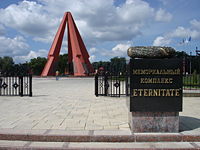
In the chaos of the Second World War Chişinău was nearly completely destroyed. This began with the Soviet occupation by the Red Army on 28 June 1940. As the city began to recover from the takeover, a devastating earthquake occurred on 10 November 1940. The epicenter of the quake, which measured 7.3 on the Richter scale, was in eastern Romania and subsequently led to substantial destruction in the city.
After scarcely one year, the assault on the newly created Moldovan SSR by the German and Romanian armies began. Beginning with July 1941 the city suffered from large-scale shooting and heavy bombardments by Nazi air raids. The Red Army resistance held until Chişinău finally fell on 17 July 1941.
Following the occupation, the city suffered from the characteristic mass murder of its predominantly Jewish inhabitants. As had been seen elsewhere in Eastern Europe, the Jews were transported on trucks to the outskirts of the city and then summarily shot in partially dug pits. The number of Jews murdered during the occupation of the city is estimated at approximately 10,000 people.[5]
As the war drew to a conclusion, the city was once more pulled into heavy fighting as German and Romanian troops retreated. Chişinău was taken by the Red Army on 24 August 1944 as a result of the Jassy-Kishinev Operation. By this point the city had lost about 70% of its buildings - the earthquake of 1940 and the air raids contributing to the largest part of this.
After the war, Bessarabia was fully integrated into the Soviet Union. Most of Bessarabia became the Moldavian SSR with Chişinău as its capital; smaller parts of Bessarabia became parts of the Ukrainian SSR.
Soviet Union
In the years 1947 to 1949 the architect Alexey Shchusev developed a plan with the aid of a team of architects for the gradual reconstruction of the city.
The beginning of the 1950s saw a rapid population growth, to which the Soviet administration responded by constructing large-scale housing and palaces in the style of Stalinist architecture. This process continued under Nikita Khrushchev, who called for construction under the slogan "good, cheaper and built faster". The new architectural style brought about dramatic change and generated the style that dominates today, with large blocks of flats arranged in considerable settlements.
The period of the most significant redevelopment of the city extended from 1971, when the Council of Ministers of the Soviet Union adopted a decision "On the measures for further development of the city of Kishinev", which secured more than one billion rubles in investment from the state budget,[6] until 1991, when Moldova gained independence, after a series of Moldovan nationalistic riots against the Russian-speaking population (Russians, Ukranians, Jews, Gagauz and others).
Many streets of Chişinău are named after historic persons, places or events. Independence from the Soviet Union was followed by a large-scale renaming of streets and localities from a Communist theme into a national one.
Politics and administration
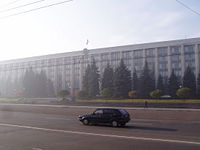
Chişinău is governed by the City Council and the City Mayor (Romanian: Primar), both elected once every four years. The current mayor is Dorin Chirtoacă. His predecessor was Serafim Urechean. Under the Moldovan constitution, Urechean - elected to parliament in 2005 - was prevented from holding an additional post to that of an MP. The Democratic Moldova Bloc leader subsequently accepted his mandate and in April resigned from his former position. During his 11 year term, Urechean committed himself to the restoration of the church tower of the Catedrala Naşterea Domnului, as well as improvements in public transport. From 1994, Chişinău saw the construction and launch of new trolleybus lines, as well as an increase in capacities of existing lines, in order to improve connections between the urban districts.
Between 23 May and 10 June 2005, the Central Election Commission received applications of possible candidates for the office of mayor. The elections took place on 10 July, 24 July, 27 November and 11 December 2005. On the first occasion only 26.93% of voters participated, below the one-third turnout necessary to validate the poll. Three subsequent attempts in July, November and December saw the election turnout fall further to 19.82%, 22.37% and 22.07% respectively. After several months in limbo it was announced that the momentary office holder Vasile Ursu, could continue to hold the position, until the next scheduled elections in 2007.
The last elections took place on 3 June 2007. Two candidates emerged from the first round - Viaceslav Iordan from the Moldovan Communist party and Dorin Chirtoacă from the Liberal party. The second round of the voting on 17 June 2007 saw the victory of Mr. Chirtoacă. 36,26 % of the voters took part in the voting, just over the validation threshold.
The first mayor of Chişinău was Angel Nour in 1817. In 1941 the office was abolished. After the Soviet era and the re-establishment of the office in 1990 Nicolae Costin became the first democratically elected mayor.
Economy
Chişinău is the most economically developed and industrialized city in Moldova. It is a major industrial and services center; its main industries include consumer and electrical goods, building materials, machinery, plastics, rubber, and textiles. The main service fields are banking and shopping/commerce. The economy of Chişinău is mainly centered on industry and services, with the latter particularly growing in importance in the last ten years.
Transport
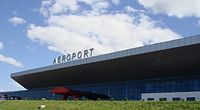
Airport
Chişinău has an international airport, which offers connections to a number of major cities including Athens, Bucharest, Frankfurt, Istanbul, Kiev, Lisbon, London, Milan, Moscow, Paris, Riga, Rome, Vienna and others. The airport handled 689.000 passengers in 2007. It has a 3 km long runway (8 and 26).
Bus and minibus
The most popular form of internal transport in Moldova is generally the bus. Bus service in Chişinău is inexpensive, ranging from 1 leu to 3 lei (ca $0.10-0.30). Although the city has just three main terminals, buses generally serve as the means of transport between different cities within and outside of Moldova. Popular destinations include Tiraspol, Odessa (Ukraine) and Bucharest (Romania).
Within Chişinău and its suburbs, privately operated minibuses, known as "marshrutkas" generally follow the major bus and trolleybus routes and appear more frequently. A minibus ride costs 3 lei within the city.
Rail
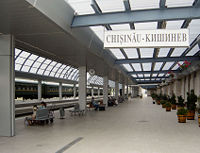
An international railway terminal exists with possible connections to Bucharest, Kiev, Minsk, Odessa and Moscow. Due to the simmering conflict between Moldova and the unrecognized Transnistria republic the rail traffic towards Ukraine is occasionally stopped.
Taxi
Taxis are very widespread in the city. Most taxis are operated by a group of companies, although there are always "illegal" or private taxi drivers who skirt the law by operating within the city limits without a permit. Many of the taxi companies have a 4-digit service hotline starting with 14-XX.
Other useful (local) short numbers: 901 - Fire Emergency Service, 902 - Police, 903 - Ambulance, 904 - Gas Emergency Service.
Education
The city is home to 12 public and 11 private universities, to the Academy of Sciences of Moldova, as well as to a number of institutions offering both high-school education, as well as 1-2 years of college education.
Since the collapse of the Soviet Union, the city has become a relatively lively and well-provisioned capital, with a much higher standard of living than in most rural areas of the country.
- See also: List of public schools in Chişinău
Architecture
In the XIX-th century the plan of growth of the city was developed. Many buildings were designed and built in a beautiful architectural frame, a lot of which embellish the city till nowadays. In 1836 the construction of the Cathedral and its belfry was finished.
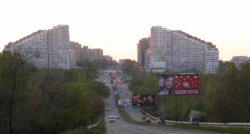
The belfry was demolished in Soviet times, but was restored after Moldova's independence, following the initiative of renowned people, the Municipality of Chisinau and thousands of citizens.
Modern architecture
Many modern-style buildings were built in the city since 1991. There are also a lot of office and shopping complexes - modern, renovated or newly built. These are Kentford, SkyTower, Union Fenosa headquarters and many others. However, the old Soviet-style clusters of living blocks are still an extensive feature of the cityscape.
People and culture

Demographics
The total population of the city proper was at 647 513 in 2004.[7]
The 2004 census reported the following ethnic composition:[8]
- 67.6% Moldovans
- 13.9% Russians
- 8.3% Ukrainians
- 4.5% Romanians
- 1.2% Bulgarians
- 0.9% Gagauzians
- 0.8% Armenians
- 1.6% others
- 1.9% undeclared
Sport
There are four professional football clubs in Chişinău, all playing in the Divizia Naţională (national league): FC Zimbru Chişinău, FC Dacia Chişinău, FC Politehnica Chişinău and CSCA-Steaua Chişinău, ranked respectively 4th, 5th, 7th and 8th tn the 2004/5 season. Of the larger football stadiums in the city, the Stadionul Republican (Republican Stadium) has 7,687 seats[9] and the Stadionul Dinamo (Dinamo Stadium) has a capacity of 2,692. The Zimbru stadium, opened in May 2006 with a capacity of 10,500 sitting places, meets all the requirements for holding official international matches, and was the venue for all Moldova's Euro 2008 qualifying games.
Media
The majority of Moldova's media industry is based in Chişinău. The only national broadcaster in the country is the state-owned Moldova 1, which has its head office in the city. The broadcasts of TeleradioMoldova have been criticized by the Independent Journalism Center as showing 'bias' towards the authorities.[10] There are some hopes that a new broadcasting code will resolve some of these issues.
The Romanian Pro TV Chişinău also broadcasts locally. It was repeatedly thwarted in its attempts to obtain a national license by the government. The station broadcasts a mixture of independent local news, in addition to entertainment and documentary programs from Romania. Pro TV remains on air despite numerous threats from Communist officials to close it down.[11]
Other TV channels are Antena C, CTC, DTV, Euro TV, MTV, MuzTV, NIT and TV 7. In addition to television, most radio and newspaper companies have their headquarters in the city. Broadcasters include the national radio, Antena C, BBC Moldova, Europa Libera, Kiss FM, Pro FM, Radio 21, Fresh FM (Romanian radio station Naţional FM), Radio Nova, Russkoe radio, Hit FM, and many others.
The biggest broadcasters are SunTV, Satellit and Zebra TV. In 2007 two companies SunTV and Zebra launched digital TV cable networks.
Music and nightlife
Chişinău is home to Moldova's largest recording labels, and is often the residence of Moldovan, and more recently Ukrainian, musicians. The city's music scene is quite eclectic. Many Moldovan rock bands of the 1970s and 1980s continue to be popular, particularly with the middle-aged, while since the 1990s there has been growth in the boy band and hip hop genres.
A famous band, Lăutarii, was established and also operates successfully in Chişinău. There is also a renowned dance group, Codreanca, which participates and wins prizes in international festivals.
Night Life
Chişinău has over a dozen clubs and cocktail-discobars. The nightlife is on almost all week long with maximum events going on on Friday and Saturday. The biggest clubs include Drive, StarTrack, Deja Vu, Dance Planet, City, and Military Club among others.
Twin Towns - Sister Cities
Chişinău is twinned with:
|
|
Gallery
Notes
- ↑ (Romanian) History of Chişinău on Kishinev.info, Retrieved on 2008-10-12
- ↑ Moldovan Ministry for Local Public Administration, Moldovan Law 764-XV from December 27, 2001, Monitorul Oficial al Republicii Moldova, no. 16/53, December 29, 2001
- ↑ Moldovan Ministry for Local Public Administration, Moldovan Law 431-XIII from April 19, 1995, Monitorul Oficial al Republicii Moldova, no. 31-32/340, June 9, 1995
- ↑ 4.0 4.1 Virtual Kishinev, accessed 23 December 2007
- ↑ "Memories of the Holocaust: Kishinev (Chisinau) (1941-1944)" from jewishvirtuallibrary.org
- ↑ Architecture of Chişinău on Kishinev.info, Retrieved on 2008-10-12
- ↑ Chişinău World Gazetteer
- ↑ 2004 census results in Moldova
- ↑ Moldova on the UEFA website. Accessed 9 November 2006.
- ↑ Monitoring of programs on Radio Moldova and TV Moldova 1PDF
- ↑ 2003 World Press Freedom Review
- ↑ (designated by Sister Cities International, Inc. (SCI))
- ↑ "Tel Aviv sister cities" (in Hebrew). Tel Aviv-Yafo Municipality. Retrieved on 2008-01-19.
Further reading
- Hamm, Michael F. (March 1998). "Kishinev: The character and development of a Tsarist Frontier Town". Nationalities Papers 26 (1): 19–37.
External links
|
Read news and contribute yourself on
Moldova News Portal
|
- www.chisinau.md - official site of Chişinău (Romanian);
- www.tochki.md - interesting places in Chişinău (Russian);
- www.virtualchisinau.com - Chisinau photo gallery by districts and other useful information (Romanian), (English);
- cam.info.md - Chisinau Live Webcam some information in (Romanian), (English), (Russian);
- Old (1995) Chişinău Photo-Gallery - a lot of artistic photos;
- Chişinău telephone directory (primarily in (Russian), some minimal content in (English), (French), (German));
- www.monument.sit.md - Architecture of historical Chisinau (Romanian)
- oldchisinau.com - Historical Chisinau in photos (Russian)
- Chişinău travel guide from Wikitravel
Maps
- Interactive Map of Chişinău (en, ro, ru)
- Map of Chişinău
- Chişinău is at coordinates
|
||||||||||||||||
|
|||||||||||||||||


